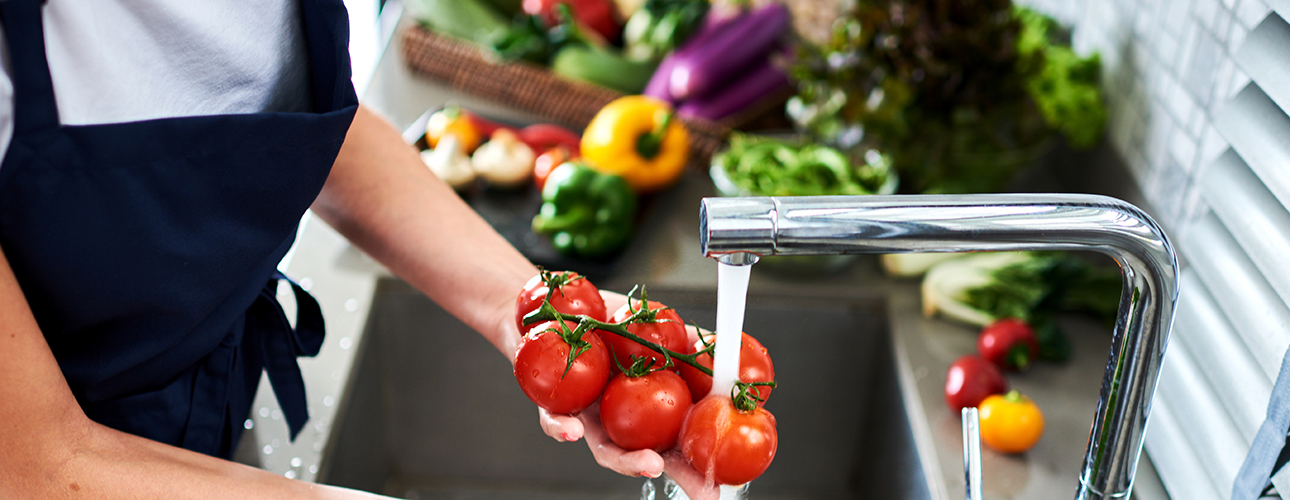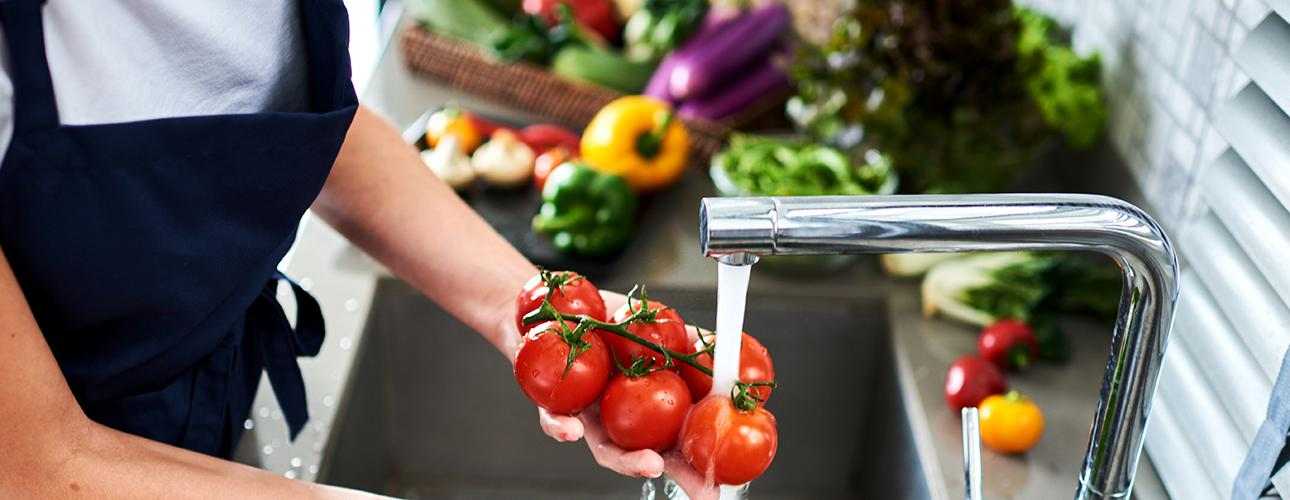There are myriad of health benefits associated with the consumption of fruits and vegetables, such as reduced risk of heart disease and stroke. At the same time, fresh produce continues to be a common vehicle for foodborne illnesses. After all, many types of produce are grown in the ground where harmful microorganisms lurk. In the United States, between 2018 and 2019, 37% of multistate foodborne outbreaks tracked by the Centers for Disease Control and Prevention (CDC) were associated with fresh produce [1]. In addition, fresh produce losses are estimated to be ca. 13.9 billion pounds per year at the retail and consumer level, which can partially be attributed to spoilage [2]. A method to prevent and control the proliferation of foodborne pathogens and spoilage microorganisms on these commodities is to incorporate a washing step. But, be careful. Recommendations for washing practices vary based on setting, which we’ll cover below.
Handlers, Processors, and Retailers
Let’s face it, fruits and vegetables, organic or not, are dirty when harvested. Washing fruits and vegetables is vitally important to reducing foodborne illness risks, improving shelf life and the visual appeal at sale. Practices among produce professionals vary but many incorporate the use of a produce wash solution rather than water alone.
The most popular chemistry for commercial produce washing is a free available chlorine or FAC for short. FAC goes by many names, such as bleach, sodium hypochlorite, hypochlorous acid, chlorine dioxide, electrolyzed water, and many more. It is an attractive chemistry because it is well known, very cheap, and authorized for use on organics (provided produce are rinsed immediately after). However, there are many downsides to FAC. FAC is generally more susceptible to inactivation by soil present on produce and is impacted by water hardness and pH compared to washes [3, 7, 8, 9, 12].
Chlorine products aren’t the only game in town. Other common chemistries used in commercial produce washing are lactic acid, phosphoric acid, citric acid, peroxyacetic acid, sodium dodecylbenzenesulfonate, ozonated water, and hydrogen peroxide just to name a few. Each chemistry has their advantages and disadvantages. But remember this: formulation matters. Products with the same level of active ingredient may perform differently based on the “other ingredients” in the products. Be sure to understand what a produce wash may offer beyond what’s established in literature. My personal favorite is peroxyacetic acid or PAA for all of the reasons noted below.
PAA is a highly efficacious organic acid that requires little to no formulation. This means what you see is what you get as far as ingredients go. Unlike chlorine products, PAA is considered no-rinse produce sanitizer even for organic produce [4, 5, 6]. This chemistry is not impacted as much as chlorine by soil load, water hardness or pH at use-dilution and normal operating conditions [7, 8, 9, 12]. The downside is odor of the concentrate can be quite pungent but dissipates significantly at most use-dilutions.
It’s important that handlers, processors, and retailers select a chemistry that fits their operational needs and not simply wash with water. These chemistries provide antimicrobial reduction power on the surface of the produce and may reduce the risk of cross contamination within the processing water. Since produce handled by these operators is widely distributed, a sanitizing wash is an important tool at this level because the public health significance is much higher.
The “At-Home” Consumer
The Food and Drug Administration (FDA) and CDC recommend only washing produce under running tap water and if the produce is firm, like a melon, to scrub with a dedicated produce brush [10, 11]. In fact, the FDA recommends avoiding the use of soaps, detergents, and even the commercial products which are made up of the chemistries I mentioned previously [11]. So, why is there a difference in the approach?
My frank opinion is there are too many nuances to produce handling and a concern that a home consumer may do more harm than good by attempting to wash an item that was likely already washed. First, most of these products are not available to the home consumer. You can quickly see how a recommendation for chemical wash may turn into a home chemistry project with household detergent, bleach, and PAA. The most important step in washing is mechanical action. If consumer begin to think the wash does all the work, then we’re all big trouble. Bottom line, commercial operators have the time, money, resources, and technical know-how to properly handle and apply the chemistries previously mentioned.
Another concern is cross contamination. Ask yourself, “When was the last time I cleaned and sanitized my sink”? Then ask yourself, “Where did I wash my hands after handling the raw chicken”? If your answer to either of those questions was somewhere along the lines of, “it’s building my immune system”, then please don’t invite me to dinner!
To be clear, at-home consumers should follow these four FDA guidelines to reduce the risk of foodborne illness associated with the consumption of fresh fruits and vegetables [10, 11]:
- Buy Right – not bruised or damaged and if pre-cut, then they must be refrigerated
- Store Properly – store perishables in a clean refrigerator (≤40 °F)
- Separate for Safety – separate produce from raw meats, poultry and seafood.
- Prepare Safely – wash your hands prior to preparation, rinse produce under running faucet before cutting, and use clean surfaces and tools, e.g. cutting board, knife.
By now, I hope you have realized the answer to the question, should produce be washed, is yes. The public health implication, shelf life and aesthetic considerations are what drive the use of produce washes in the industry. At home, users should stick with the simple running water rinse. If you’re a handler, processor, or retailer, the next question you may ask is, “Am I using the right produce wash?” Reach out to our team if you’re not sure.
References:
- List of Selected Multistate Foodborne Outbreak Investigations. https://www.cdc.gov/foodsafety/outbreaks/multistate-outbreaks/outbreaks-list.html. (Accessed on September 21, 2021)
- Buzby, J. C., Wells, H. F., & Hyman, J. (2014). The estimated amount, value, and calories of postharvest food losses at the retail and consumer levels in the United States. Retrieved from www.ers.usda.gov.
- Lee, W. N., & Huang, C. H. (2019). Formation of disinfection byproducts in wash water and lettuce by washing with sodium hypochlorite and peracetic acid sanitizers. Food Chemistry: X, 1, 100003.
- Chemicals used in washing or to assist in the peeling of fruits and vegetables, 21 CFR § 173.315. https://www.accessdata.fda.gov/scripts/cdrh/cfdocs/cfcfr/CFRSearch.cfm?fr=173.315.
- Synthetic substances allow for use in organic crop product. 7 CFR § 205.601. https://www.govinfo.gov/app/details/CFR-2003-title7-vol3/CFR-2003-title7-vol3-sec205-601. (Accessed September 21, 2021).
- Nonagricultural (nonorganic) substances allowed as ingredients in or on processed products labeled as “organic” or “made with organic (specified ingredients or food group(s)).” 7 CFR § 205.605. https://www.govinfo.gov/app/details/CFR-2011-title7-vol3/CFR-2011-title7-vol3-sec205-605. (Accessed September 21, 2021).
- Rutala, W. A., & Weber, D. J. (2008). Guideline for disinfection and sterilization in healthcare facilities, 2008.
- Wessels, S., & Ingmer, H. (2013). Modes of action of three disinfectant active substances: a review. Regulatory toxicology and pharmacology, 67(3), 456-467.
- Shen, X., Sheng, L., Gao, H., Hanrahan, I., Suslow, T., & Zhu, M. (2019). Enhanced efficacy of peroxyacetic acid against Listeria monocytogenes on fresh apples at elevated temperature. Frontiers in microbiology, 10, 1196.
- Selecting and Serving Produce Safely. https://www.fda.gov/food/buy-store-serve-safe-food/selecting-and-serving-produce-safely. (Accessed on September 21, 2021)
- Fruit and Vegetable Safety. https://www.cdc.gov/foodsafety/communication/steps-healthy-fruits-veggies.html. (Accessed on September 21, 2021)
- Swanson, S., & Fu, T. J. (2017). Effect of water hardness on efficacy of sodium hypochlorite inactivation of Escherichia coli O157: H7 in water. Journal of food protection, 80(3), 497-501.



